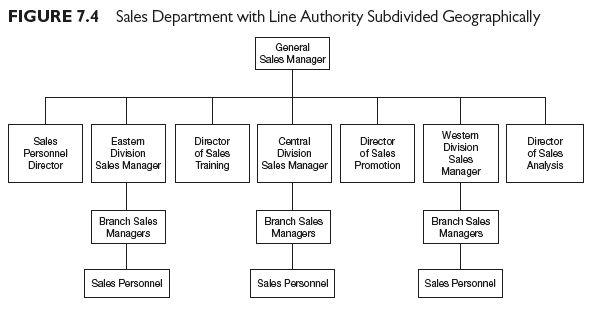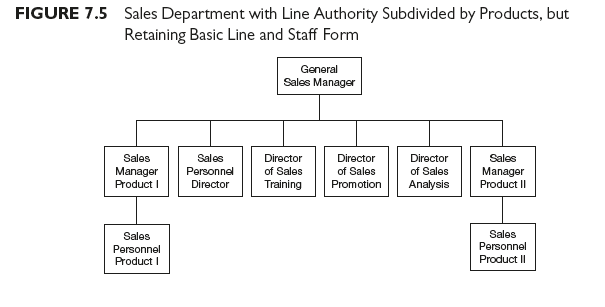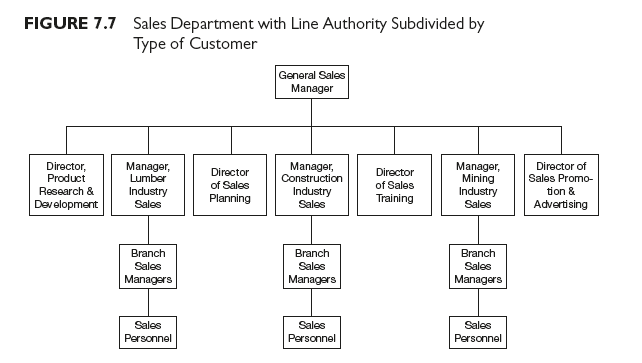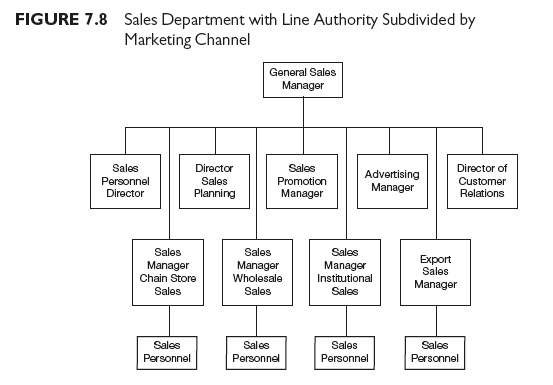As marketing operations expand, line authority and responsibility eventually become excessively burdensome for the top sales executive. There is an increasing number of people to supervise. Ordinarily, the first remedial step taken is to add a general line assistant, for example, an assistant general sales manager. As the burden of line administrative work continues to grow, it is necessary to provide additional assistants. These new subordinates are given line responsibilities narrower than those of the assistant general sales manager. Although they work with a variety of matters, their assignments cover a limited area of operations. Tasks of line administration are subdivided among these new assistants in one of three ways: (1) by geographic area, (2) by products, or (3) by customers or marketing channels.
1. Geographic Division of Line Authority
The large firm with far-flung selling operations is likely to subdivide line authority geographically (see Figure 7.4). This is particularly so if the characteristics of large numbers of customers vary by geographic location, if different selling problems are encountered in different areas, or if certain products are more strongly demanded in some regions than in others. But there is an even more compelling reason for dividing line authority geographically—as more customers are added and as a wider area is cultivated, the size of the sales task increases enormously. Setting up geographic divisions is a way of cutting the sales task down to manageable proportions. When centralized administration becomes too great a burden for the top sales executives, secondary line executives are delegated authority to conduct sales operations within smaller areas. Geographic division is usually made first into regions or divisions. These may or may not be broken down further into districts or branches.

When line authority is divided geographically, local problems are handled speedily. It is not necessary to wait for decisions from the home office; many questions of importance to customers can be answered by executives personally acquainted with local conditions. Shortening the lines of communication makes possible closer supervision of salespeople, which, in turn, helps in improving customer service. Local markets can be cultivated intensively, and tactics of local competitors can be met and countered in the field.
However, this system calls for multiple offices, so administrative expenses increase. Then, too, the top sales executive faces coordinating several regional operations. Unless this coordination is effective, conflicting policies may develop in different regions.
2. Product Division of Line Authority
A second scheme for dividing line authority is to split the sales task among subordinate line executives, each of whom directs sales operations for part of the product line. When authority is so divided, more than one sales force may be required. Some companies’ product lines are too wide to be distributed economically by a single sales force. Others sell both highly technical and nontechnical products; thus some salespeople need specialized training and some do not. In still others, economies of a single sales force are reduced or eliminated because different products are marketed to different types of customers.
Figures 7.5 and 7.6 illustrate two schemes for dividing line authority by products. In Figure 7.5, the customary line and staff organization has been retained; in Figure 7.6, the primary division is on the basis of products, and each product sales manager has his own staff of specialists.


The use of separate staffs, shown in Figure 7.6, is unusual. Often this is an intermediate stage resulting from a merger. Because of the expenses incurred in maintaining duplicate staffs, most companies, after mergers, gradually change the organization to its basic line and staff form shown in Figure 7.5. Unless there are strong reasons for retaining separate sales managers and sales forces, as will shortly be explained, line authority should be divided on some basis other than products.
The decision to use the product type of sales organization should rest on whether the benefits of product specialization outweigh the additional expenses. If they do not, it is wiser to organize the sales force on some other basis. Gains associated with specialized salespersons, who concentrate on selling specific products, must be outweighed against increased expenses. Maintaining more than one sales force results in higher administrative and travel expenses. There are almost certain to be times when two company sales personnel selling different products make calls on the same customers. Although specialized salespeople may give more “push” to individual products, many customers object to multiple calls from the same company. The benefits of specialized sales forces are greatest for companies selling broadly diversified lines, reaching different markets with different products, and encountering unique selling problems for the various products.
3. Customer (or Marketing Channel) Division of Line Authority
The third scheme for subdividing line authority is by type of customer (Figure 7.7) or marketing channel (Figure 7.8). This is appropriate when nearly identical products are marketed to several types of customers and the problems of selling to each type are different. When the same, or similar, products are sold to a number of industries, they often find different applications in each industry. The company in Figure 7.7 sells its products to the lumber, construction, and mining industries. In each industry, the products are used for different purposes. Customers not only have different needs, they are influenced by different buying motives. Thus, special sales forces sell to each major type of customer.


Other companies, especially in the consumer-goods field, pattern their sales organizations after the marketing channels. Although ultimate consumers may be substantially alike, they frequently must be reached in different ways (that is, they may buy the product in different types of outlets). Problems of distributing to chain stores are often unlike those of selling to independent wholesalers and retailers, and specialized sales training programs are often required. In cases of this kind, the problems of selling vary more with the marketing channel than they do with the product or geographical location; consequently, line authority is subdivided according to marketing channels.
4. Dividing Line Authority on More than One Basis
Few companies use a single basis for subdividing line authority. Most use a combination, subdividing the selling task more than once, to permit greater specialization. Nearly every large sales department subdivides authority on the geographic basis at some level of organization, but this is done usually in combination with either the product or type-of-customer system. If geographical differences are more important than those of product or type of customer, the primary subdivision is geographical, and the next is at a lower organizational echelon according to one of the other bases. If geographical differences are of lesser importance, the procedure is reversed. The factor most important to the marketing success of the company should form the basis for the first subdivision, and less important factors should determine subsequent breakdowns at lower organizational echelons.
Source: Richard R. Still, Edward W. Cundliff, Normal A. P Govoni, Sandeep Puri (2017), Sales and Distribution Management: Decisions, Strategies, and Cases, Pearson; Sixth edition.

25 May 2021
25 May 2021
25 May 2021
25 May 2021
25 May 2021
25 May 2021